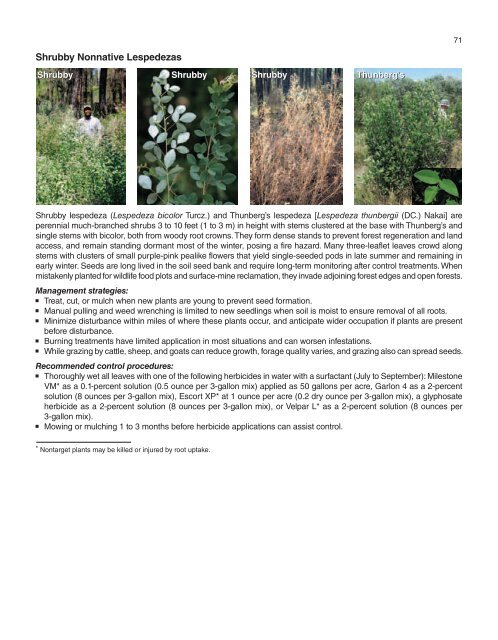A Management Guide for Invasive Plants in Southern Forests James ...
A Management Guide for Invasive Plants in Southern Forests James ...
A Management Guide for Invasive Plants in Southern Forests James ...
- No tags were found...
Create successful ePaper yourself
Turn your PDF publications into a flip-book with our unique Google optimized e-Paper software.
71Shrubby Nonnative LespedezasShrubbyShrubbyShrubbyThunberg’sShrubby lespedeza (Lespedeza bicolor Turcz.) and Thunberg’s lespedeza [Lespedeza thunbergii (DC.) Nakai] areperennial much-branched shrubs 3 to 10 feet (1 to 3 m) <strong>in</strong> height with stems clustered at the base with Thunberg’s ands<strong>in</strong>gle stems with bicolor, both from woody root crowns. They <strong>for</strong>m dense stands to prevent <strong>for</strong>est regeneration and landaccess, and rema<strong>in</strong> stand<strong>in</strong>g dormant most of the w<strong>in</strong>ter, pos<strong>in</strong>g a fire hazard. Many three-leaflet leaves crowd alongstems with clusters of small purple-p<strong>in</strong>k pealike flowers that yield s<strong>in</strong>gle-seeded pods <strong>in</strong> late summer and rema<strong>in</strong><strong>in</strong>g <strong>in</strong>early w<strong>in</strong>ter. Seeds are long lived <strong>in</strong> the soil seed bank and require long-term monitor<strong>in</strong>g after control treatments. Whenmistakenly planted <strong>for</strong> wildlife food plots and surface-m<strong>in</strong>e reclamation, they <strong>in</strong>vade adjo<strong>in</strong><strong>in</strong>g <strong>for</strong>est edges and open <strong>for</strong>ests.<strong>Management</strong> strategies:Treat, cut, or mulch when new plants are young to prevent seed <strong>for</strong>mation.Manual pull<strong>in</strong>g and weed wrench<strong>in</strong>g is limited to new seedl<strong>in</strong>gs when soil is moist to ensure removal of all roots.M<strong>in</strong>imize disturbance with<strong>in</strong> miles of where these plants occur, and anticipate wider occupation if plants are presentbe<strong>for</strong>e disturbance.Burn<strong>in</strong>g treatments have limited application <strong>in</strong> most situations and can worsen <strong>in</strong>festations.While graz<strong>in</strong>g by cattle, sheep, and goats can reduce growth, <strong>for</strong>age quality varies, and graz<strong>in</strong>g also can spread seeds.Recommended control procedures:Thoroughly wet all leaves with one of the follow<strong>in</strong>g herbicides <strong>in</strong> water with a surfactant (July to September): MilestoneVM* as a 0.1-percent solution (0.5 ounce per 3-gallon mix) applied as 50 gallons per acre, Garlon 4 as a 2-percentsolution (8 ounces per 3-gallon mix), Escort XP* at 1 ounce per acre (0.2 dry ounce per 3-gallon mix), a glyphosateherbicide as a 2-percent solution (8 ounces per 3-gallon mix), or Velpar L* as a 2-percent solution (8 ounces per3-gallon mix).Mow<strong>in</strong>g or mulch<strong>in</strong>g 1 to 3 months be<strong>for</strong>e herbicide applications can assist control.* Nontarget plants may be killed or <strong>in</strong>jured by root uptake.
















